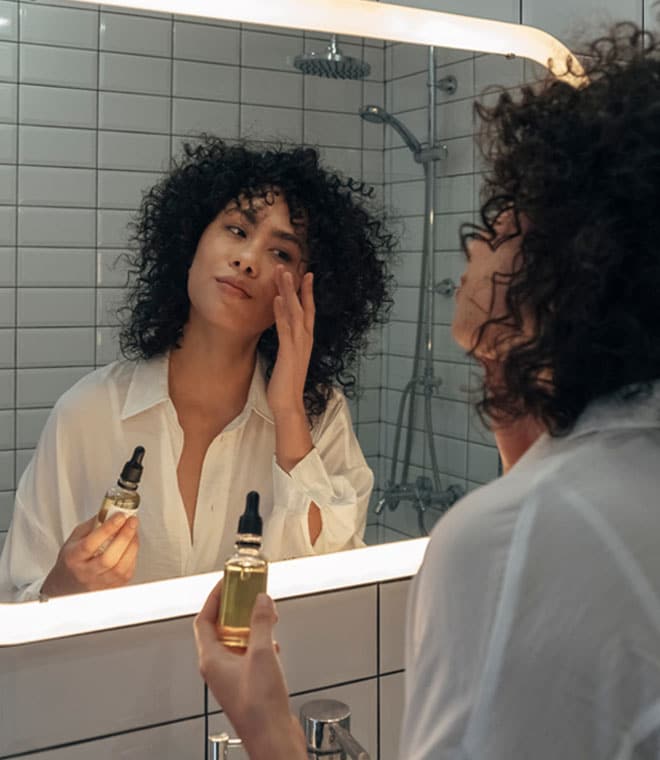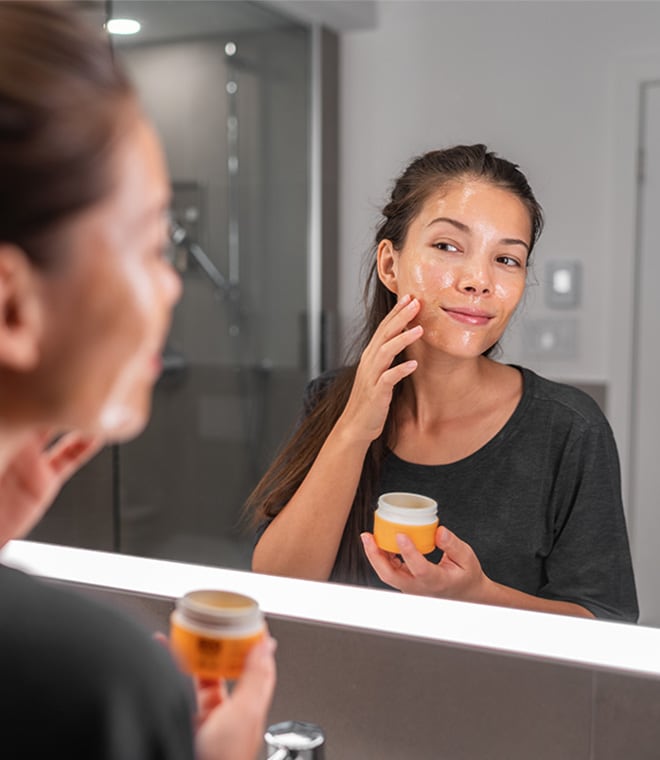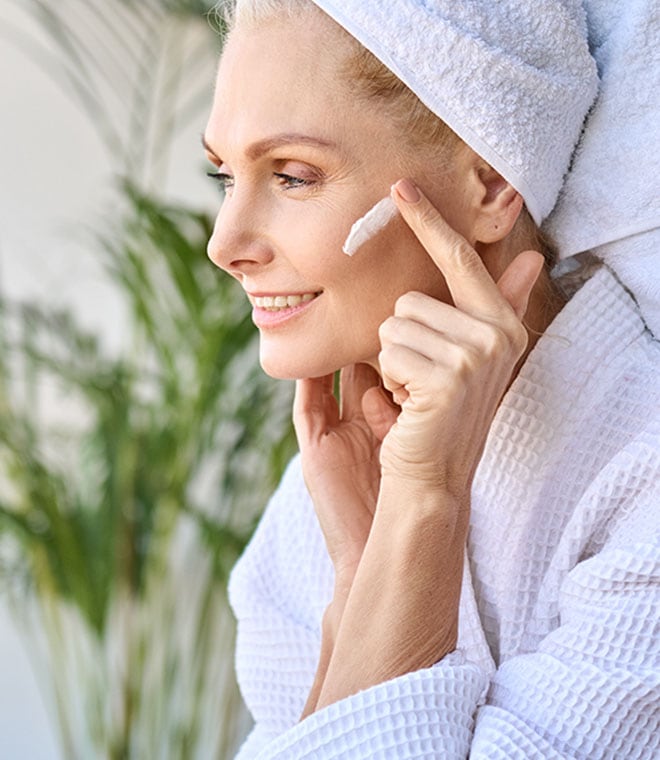Health
Wrinkle treatment: How to reduce wrinkles and fine lines
By Anna H. Chacon, MD, Fellow of the American Academy of Dermatology Jul 26, 2024 • 8 min
There are many topical products and clinical interventions that can help diminish the appearance of fine lines and wrinkles. As you weigh your options, discuss wrinkle treatment with your healthcare provider for advice on which products and procedures are most likely to benefit you.
Anti-aging skin care products
For those exploring how to reduce wrinkles from the forehead, around the eyes or mouth, on the neck or in another area, anti-aging skin care products are often a first step. Healthcare providers typically recommend a regimen that includes:
- A gentle facial cleanser to remove impurities
- A moisturizer to hydrate the skin, potentially reducing the appearance of lines
- A sunscreen applied in the morning to protect skin from sun damage
After cleansing and before moisturizing, you can apply treatments, such as creams, serums and lotions. Some key ingredients found in anti-aging treatments include the following:
1. Retinoids: A derivative of vitamin A, retinoids aid in cellular turnover, helping your skin shed dead cells. Over time, they may make lines and wrinkles less prominent while increasing collagen thickness to support more youthful-looking skin.
Some examples of topical retinoids include retinol and adapalene, which are available over the counter.
Retinoids may cause dryness, redness and irritation in some people. Gradually increasing usage and applying a daily moisturizer may help reduce these side effects. Because retinol can cause sun sensitivity, healthcare providers generally recommend applying a broad-spectrum sunscreen with an SPF of at least 30 daily.
2. Alpha hydroxy acids: Naturally occurring substances, alpha hydroxy acids (AHAs), like glycolic acid and lactic acid, break the bonds that hold dead skin in place on the surface of the complexion. This chemical exfoliation may make lines and wrinkles less prominent while also enhancing radiance and minimizing dark spots. In addition to products intended for use on the face, you can find AHA lotions that serve as body and neck wrinkle treatments.
The most common side effect of alpha hydroxy acids is redness. Starting with a mild product may help reduce this risk. AHA products may increase your skin's sensitivity to the sun, so be sure to wear sunscreen or sun protective clothing while using these products and for one week after stopping.
3. Hyaluronic acid: Naturally present in the skin, hyaluronic acid draws in moisture and helps it bind to the tissue. It often comes in serum form and may help plump and firm skin while also supporting overall hydration.
4. Vitamin C: An essential vitamin, vitamin C plays a role in the production of collagen, the structural protein that helps support the skin. It also acts as an antioxidant, breaking down free radicals that drive the aging process. Some studies have found that vitamin C may help diminish lines and wrinkles.
Prescription-strength retinoids
Like retinol, prescription-strength retinoids are derivatives of vitamin A. They provide similar benefits as the retinol found in some over-the-counter wrinkle treatments but at a higher concentration for greater efficacy. Prescription retinoids include:
- Tazarotene
- Tretinoin
- Trifarotene
Redness, dryness and irritation may occur with retinoid usage. As a result, healthcare providers often recommend using it every other night at first and then gradually building up to daily use. Because prescription-strength retinoids may cause sun sensitivity, daily use of a broad-spectrum sunscreen with an SPF of at least 30 is usually recommended.
Botulinum toxin therapy
Better known by the brand name Botox, botulinum toxin injections are a treatment for wrinkles around the eyes and on the forehead. They work by blocking the signals that trigger muscle contractions, helping skin appear smoother. Most people see results within three to seven days of an injection, and benefits may last for about three to four months.
Some common side effects of botulinum toxin therapy include:
- Bruising
- Redness
- Soreness
- Swelling
Mild headaches, weakness in neighboring muscles and signs and symptoms of botulism may also occur, but these side effects are less common.
Chemical peels
Also called chemexfoliation or derma peeling, chemical peels diminish fine lines and wrinkles by exfoliating the skin. There are different types available, and your healthcare provider will consider the depth of your wrinkles and other factors when determining which is right for you.
In most cases, you’ll need to follow a pre-peel skin care regimen for two to four weeks before the procedure. After a peel, redness, swelling and blisters may occur. Depending on the type of peel, it may take up to 21 days for the skin to heal completely.
Fillers
Another type of cosmetic injection, fillers are treatments for deep creases, fine lines and wrinkles. They include:
- Calcium hydroxylapatite (Radiesse)
- Poly-L-lactic acid (Sculptra)
- Hyaluronic acid (Restylane products, Juvederm products, Belotero Balance, Revanesse Versa, the RHA collection)
- Polymethylmethacrylate (PMMA) (Bellafill)
Fillers work by plumping the skin to make it appear smoother. Healthcare providers typically recommend one to three filler injections to achieve the desired results. Touch-ups may be necessary every six months.
Potential side effects of fillers include redness, swelling, tenderness and bruising. In most cases, these side effects resolve within seven to 14 days.
Laser resurfacing
Performed on an outpatient basis, laser resurfacing helps rejuvenate the skin and reduce the prominence of lines and wrinkles. There are two main types of laser resurfacing procedures:
- Ablative lasers remove the outer layer of the skin and stimulate collagen production.
- Non-ablative lasers leave the outer layer of skin intact and work by stimulating collagen production. They’re less invasive but tend to produce less prominent results.
Redness, swelling, itching and pain are some common side effects. Laser resurfacing may lead to infections, changes in skin color and scarring.
When considering a clinical wrinkle treatment, ask your healthcare provider which options may be appropriate for your health and skin. Some procedures should only be performed by a trained healthcare professional in a clinical setting in order to manage any potential side effects. You should discuss any health conditions you may have before the procedure. Certain treatments, such as dermal fillers, may not be appropriate for some people with certain health conditions, such as bleeding disorders and allergies.
Published July 2024.
Sources:
- https://www.aad.org/public/cosmetic/wrinkles/botulinum-toxin-overview
- https://www.aad.org/public/cosmetic/younger-looking/chemical-peels-overview
- https://www.health.harvard.edu/blog/drugstore-skincare-science-backed-anti-aging-ingredients-that-dont-break-the-bank-2020111121309
- https://www.aad.org/public/cosmetic/wrinkles/fillers-overview
- https://www.mayoclinic.org/tests-procedures/laser-resurfacing/about/pac-20385114
- https://www.aad.org/public/everyday-care/skin-care-secrets/anti-aging/retinoid-retinol
- https://www.health.harvard.edu/blog/why-is-topical-vitamin-c-important-for-skin-health-202111102635
- https://my.clevelandclinic.org/health/diseases/10984-wrinkles
- https://www.mayoclinic.org/diseases-conditions/wrinkles/diagnosis-treatment/drc-20354931
- https://health.clevelandclinic.org/anti-aging-skin-care
- https://www.fda.gov/regulatory-information/search-fda-guidance-documents/guidance-industry-labeling-cosmetics-containing-alpha-hydroxy-acids
- https://health.clevelandclinic.org/vitamin-c-serum
- https://www.fda.gov/drugs/special-features/sun-and-your-medicine
- https://www.aad.org/public/cosmetic/younger-looking/chemical-peels-faqs
- https://www.americanboardcosmeticsurgery.org/procedure-learning-center/non-surgical/injectable-fillers-guide/
- https://www.fda.gov/consumers/consumer-updates/dermal-filler-dos-and-donts-wrinkles-lips-and-more




